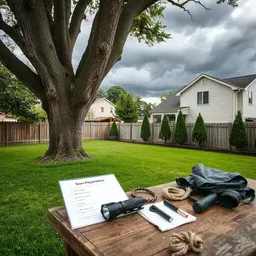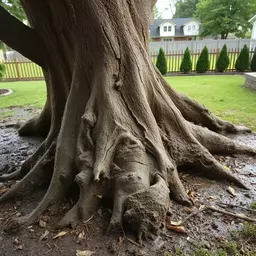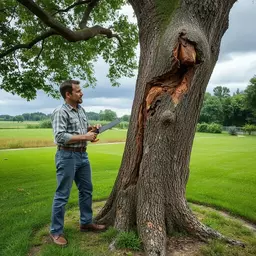Hazardous Tree Removal Best Practices

Are you aware that trees, while offering beauty and shade, can also pose significant risks to your home and safety? Understanding the importance of hazardous tree removal is crucial for every homeowner. Let's delve into the key takeaways that can help you ensure the safety of your property and loved ones.
What You Will Learn
- Recognize the signs of hazardous trees, such as cracks in the trunk, dead branches, and leaning limbs.
- Conduct a tree risk assessment by evaluating the tree's proximity to structures and historical storm damage.
- Implement essential safety protocols for tree removal, including wearing personal protective equipment (PPE) and establishing a safe work zone.
- Understand and comply with local regulations regarding tree removal, ensuring you are aware of necessary permits and environmental considerations.
- Familiarize yourself with ANSI A300 standards for safe tree care practices to enhance both safety and quality.
- Take action by consulting professional arborists for thorough inspections and expert recommendations on hazardous trees.
- Explore additional resources on tree care to empower yourself with knowledge and ensure the safety of your property.
Key Indicators of Hazardous Trees
Understanding the signs of hazardous trees is crucial for homeowners. Below are key indicators that can help you assess the risk associated with trees in your yard.
Cracks in the Trunk
Indicate structural weakness and potential hazards.
Dead Branches
Can fall unexpectedly, posing a risk to safety.
Root Damage
Soil erosion or root rot can lead to instability.
Leaning Trees
Significantly leaning trees are at risk of falling.
Understanding the Importance of Hazardous Tree Removal
When it comes to the safety of our homes, trees can be both beautiful and potentially dangerous. At Safe Canopy Care, we understand the critical importance of recognizing when a tree poses a threat to your property and loved ones. Hazardous tree removal is not just about aesthetics; it’s about protecting your space from potential damage and harm. Let's explore the dangers these trees can present and how you can identify them.
Recognizing the Dangers of Hazardous Trees
Did you know that some trees can become hazardous without obvious signs? Understanding tree hazards is essential for every homeowner. There are a few key indicators that can help you recognize when a tree could be a risk:
- Cracks in the trunk: These can indicate structural weakness.
- Dead branches: Over time, these can fall unexpectedly.
- Root damage: Soil erosion or root rot can lead to instability.
- Leaning trees: If a tree is leaning significantly, it may be at risk of falling.
Identifying Signs of Tree Hazards
Every tree has its own personality, and some may show subtle clues that they need attention. As a tree safety expert, I've seen my fair share of alarming signs! Here are some common issues to look for:
- Fungal growth at the base of the tree.
- Excessive leaf loss during growing seasons.
- Visible decay in the trunk or branches.
- Insect infestations that compromise tree health.
Being vigilant and proactive about these signs can help you avoid potential disasters, especially during stormy weather.
Assessing Risks to Property and Safety
Before making any decisions, it's crucial to assess the risks your tree poses to your property and safety. Start by considering the following:
- Proximity to structures: Is the tree too close to your home or utility lines?
- Historical storm damage: Has this tree caused issues in the past?
- Tree species: Some species are more prone to failure than others.
By examining these factors, you can get a clearer picture of whether a tree is a hazard that needs removal. Remember, safety should be your top priority!
Conducting a Tree Risk Assessment
So, how do you conduct a proper tree risk assessment? While it may sound daunting, it doesn't have to be! Here’s a simple process to follow:
- Inspect the tree for visible signs of damage or decay.
- Evaluate the surrounding area for potential hazards.
- Consult a certified arborist for a professional assessment.
At Safe Canopy Care, we offer comprehensive assessments to help you understand the condition of your trees. By investing in a professional evaluation, you can gain peace of mind and ensure the safety of your property.
Essential Safety Protocols for Hazardous Tree Removal
Once you've recognized the importance of hazardous tree removal, it's time to implement essential safety measures. These protocols are crucial to ensure a safe and effective removal process for both professionals and homeowners alike.
Important Reminder
As you consider hazardous tree removal, keep in mind the following:
- Regular tree inspections can help catch potential hazards early.
- Understanding your tree's species can inform you about its health and stability.
- Always prioritize safety by consulting with professionals when in doubt.
Staying proactive will not only protect your property but also enhance the beauty of your landscape!
Summarizing Best Practices for Hazardous Tree Removal
When it comes to hazardous tree removal, understanding the best practices is crucial for safety and efficiency. At Safe Canopy Care, I always emphasize that following established protocols can prevent accidents and protect your property. Keeping in mind a few key takeaways can make a world of difference in your approach to tree removal.
First and foremost, adherence to safety protocols is not just a recommendation; it's a must. This means wearing the right gear, using proper techniques, and ensuring that everyone involved understands their roles. For instance, the safety protocols outlined by the U.S. Army Corps of Engineers provide comprehensive guidelines for tree work. By prioritizing safety, you not only protect yourself but also the people around you. Remember, preventive measures today can save you from disasters tomorrow!
- Wear appropriate personal protective equipment (PPE). Resources from the CDC's NIOSH offer valuable insights into safety equipment for tree care.
- Conduct a thorough risk assessment before starting.
- Establish a safe work zone to keep bystanders away.
Key Takeaways on Safety and Compliance
Next, let’s discuss the essential regulations that govern hazardous tree work. It’s vital to be aware of local laws, which often dictate how and when tree removals can occur. At Safe Canopy Care, we work diligently to comply with these regulations to avoid any potential legal issues. Staying informed ensures you’re not only acting responsibly but also protecting the environment.
Understanding ANSI A300 standards is another critical aspect. These guidelines help define best practices for arboriculture, from pruning to tree removal. By following these standards, you ensure that your practices are safe and effective. For additional guidance on safety in tree trimming, consider resources like those provided by Kansas State University Research and Extension. So, be sure to familiarize yourself with them if you plan to undertake any tree care work.
- Research local regulations to comply with tree removal laws.
- Follow ANSI A300 standards for safe practices.
- Keep records of all tree care activities for future reference.
Importance of Adhering to Safety Protocols
As we wrap up this section, I can't stress enough the importance of adhering to safety protocols. Not only do they help in preventing accidents, but they also promote a culture of safety in the community. At Safe Canopy Care, we encourage homeowners to adopt these practices and share their experiences. This collaborative approach can make our neighborhoods safer for everyone!
Essential Regulations for Hazardous Tree Work
In case you decide to hire a professional or even take on the task yourself, keep these essential regulations in mind:
- Check with local authorities regarding permits needed for tree removal.
- Understand any environmental considerations that apply, such as tree preservation ordinances.
- Be aware of utility companies and ensure that their lines are not endangered.
Understanding ANSI A300 Standards
Lastly, let’s talk about the ANSI A300 standards. These guidelines will help you maintain a high level of care when dealing with tree removal. They cover everything from the tools you should use to the methodologies for safe cutting and disposal. Following these standards not only enhances safety but also boosts the quality of your tree care practices!
- Familiarize yourself with the specific ANSI A300 standards applicable to tree removal.
- Always use the right equipment for the job as outlined in the standards.
- Consider hiring certified arborists to ensure compliance with these standards.
Taking Action for Safe Tree Removal
Now that you understand the best practices, it’s time to take action. If you suspect a tree in your yard may be hazardous, don't hesitate to reach out to professional arborists for an assessment. At Safe Canopy Care, I am always ready to help homeowners navigate these concerns with expert advice and hands-on assistance.
Contacting Professional Arborists for Assessment
When you contact a professional arborist, here’s what you can expect during a consultation:
- A thorough inspection of your trees to identify risks.
- Expert recommendations for removal or mitigation.
- A detailed plan of action based on your specific needs.
By taking this step, you can ensure that any hazardous trees are dealt with safely and efficiently. Remember, a proactive approach can make all the difference in protecting your home and family!
Exploring Further Resources on Tree Care
To further your knowledge about tree safety and care, consider these additional resources:
- Educational materials and guides on tree health available at local libraries or online.
- Local workshops or training sessions focused on tree safety practices.
- Resources from the Tree Care Industry Association (TCIA), which offers a wealth of information on tree care standards and best practices.
These resources can empower you to take charge of your trees and the safety of your property. Together, we can cultivate a community that values tree care and safety! So let’s get started today!
Recap of Key Points
Here is a quick recap of the important points discussed in the article:
- Recognize hazardous trees by checking for cracks, dead branches, root damage, and leaning structure.
- Conduct regular inspections for signs of fungal growth, excessive leaf loss, decay, and insect infestations.
- Assess risks by considering tree proximity to structures, historical storm damage, and species vulnerability.
- Follow a structured tree risk assessment process: inspect, evaluate, and consult a professional.
- Always wear appropriate personal protective equipment (PPE) during tree removal.
- Stay compliant with local regulations and adhere to ANSI A300 standards for safe tree care practices.
- Contact professional arborists for a thorough inspection and expert recommendations on hazardous trees.
- Utilize additional resources such as educational materials, local workshops, and information from the Tree Care Industry Association (TCIA).
Frequently Asked Questions About Hazardous Tree Removal
- What are the key signs of a hazardous tree?
- Key signs include cracks in the trunk, dead branches, root damage (e.g., from soil erosion or rot), and significant leaning. Other indicators are fungal growth at the base, excessive leaf loss during growing seasons, visible decay, and insect infestations.
- How does proximity to structures affect tree hazard assessment?
- A tree's proximity to structures like your home or utility lines significantly increases the risk of damage if it falls. This is a critical factor in determining if a tree is hazardous and requires removal.
- What is a tree risk assessment, and why is it important?
- A tree risk assessment involves inspecting the tree for damage, evaluating potential hazards in the surrounding area, and often consulting a certified arborist. It's crucial for identifying potential dangers and ensuring the safety of your property and loved ones.
- What safety protocols should be followed during tree removal?
- Essential safety protocols include wearing appropriate personal protective equipment (PPE), conducting a thorough risk assessment before starting, and establishing a safe work zone to keep bystanders away. It's also vital to follow established guidelines such as those from the U.S. Army Corps of Engineers and NIOSH.
- What are ANSI A300 standards, and why are they relevant to tree care?
- ANSI A300 standards are guidelines that define best practices for arboriculture, covering everything from pruning to tree removal. Adhering to these standards ensures that tree care practices are safe, effective, and of high quality.
- When should I contact a professional arborist?
- You should contact a professional arborist if you suspect a tree in your yard may be hazardous. They can conduct a thorough inspection, provide expert recommendations for removal or mitigation, and develop a detailed plan of action tailored to your specific needs.
Popular Posts
 As homeowners, understanding the potential dangers storms pose to our landscapes can be the differen
As homeowners, understanding the potential dangers storms pose to our landscapes can be the differen
 What if your seemingly intact tree holds hidden dangers? After a storm, many homeowners overlook the
What if your seemingly intact tree holds hidden dangers? After a storm, many homeowners overlook the
 Have you ever thought about the hidden dangers that trees on your property might pose? While they pr
Have you ever thought about the hidden dangers that trees on your property might pose? While they pr
 As storms become more frequent and severe, the safety of your property and loved ones relies heavily
As storms become more frequent and severe, the safety of your property and loved ones relies heavily
